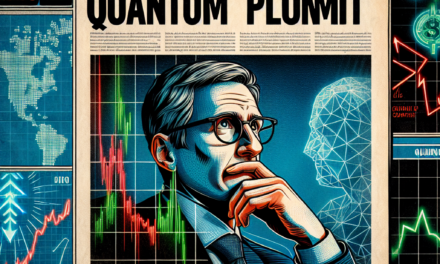“Tech Titans and Retail Giants: Nvidia’s Resilience Meets Walmart’s Retail Dominance Ahead of Q3 Revelations”
Introduction
Nvidia’s stock continues to demonstrate resilience and strength as the company approaches the release of its third-quarter financial results. Investors and analysts are keenly observing Nvidia’s performance, given its pivotal role in the technology sector, particularly in areas such as artificial intelligence, gaming, and data centers. The anticipation surrounding Nvidia’s earnings is heightened by its recent strategic moves and product launches, which have bolstered its market position. Meanwhile, in the retail sector, Walmart stands out as a key player, topping the lineup of retail reports. As a leading retail giant, Walmart’s performance is often seen as a barometer for consumer spending trends and economic health. The company’s results are expected to provide valuable insights into the retail landscape, especially as it navigates challenges such as supply chain disruptions and shifts in consumer behavior. Together, Nvidia and Walmart’s upcoming reports are set to capture significant attention from investors and market watchers, offering a glimpse into the broader economic and sector-specific dynamics.
Nvidia’s Market Resilience: Analyzing Stock Performance Pre-Q3 Results
Nvidia’s market resilience has been a topic of considerable interest among investors and analysts alike, particularly as the company approaches the release of its third-quarter results. The semiconductor giant has consistently demonstrated robust performance in the stock market, a trend that appears to be holding steady even as the broader economic landscape presents a mix of challenges and opportunities. This resilience can be attributed to several key factors that continue to bolster investor confidence and maintain Nvidia’s strong market position.
Firstly, Nvidia’s strategic focus on innovation and diversification has played a crucial role in sustaining its stock performance. The company’s advancements in artificial intelligence, gaming, and data center technologies have not only expanded its market reach but also solidified its reputation as a leader in cutting-edge technology. By continually pushing the boundaries of what is possible, Nvidia has managed to capture significant market share in these high-growth sectors, thereby driving revenue and, consequently, stock value.
Moreover, Nvidia’s ability to adapt to changing market dynamics has further reinforced its stock’s resilience. The global semiconductor shortage, which has posed challenges for many in the industry, has been navigated adeptly by Nvidia. Through strategic partnerships and supply chain optimizations, the company has managed to mitigate potential disruptions, ensuring a steady flow of products to meet consumer demand. This proactive approach has not only safeguarded Nvidia’s market position but also instilled confidence among investors who view the company as a reliable player in an otherwise volatile market.
In addition to its operational strategies, Nvidia’s financial health has been a significant factor in its stock’s strong performance. The company has consistently reported impressive earnings, with revenue growth driven by its core segments. As Nvidia prepares to release its third-quarter results, expectations remain high, with analysts predicting continued growth in both revenue and profit margins. This anticipation is reflected in the stock’s performance, as investors remain optimistic about the company’s ability to deliver strong financial results.
Transitioning to the broader retail sector, Walmart has emerged as a standout performer, topping the retail report lineup. The retail giant’s success can be attributed to its strategic initiatives aimed at enhancing customer experience and expanding its digital footprint. Walmart’s investment in e-commerce and technology-driven solutions has enabled it to capture a larger share of the market, particularly as consumer preferences shift towards online shopping. This strategic pivot has not only driven revenue growth but also positioned Walmart as a formidable competitor in the retail space.
Furthermore, Walmart’s focus on sustainability and corporate responsibility has resonated well with consumers, further strengthening its brand image. By prioritizing initiatives that promote environmental stewardship and social responsibility, Walmart has managed to differentiate itself from competitors, thereby attracting a loyal customer base. This commitment to sustainable practices has not only enhanced Walmart’s reputation but also contributed to its financial success, as consumers increasingly favor brands that align with their values.
In conclusion, both Nvidia and Walmart exemplify resilience and strategic foresight in their respective industries. Nvidia’s focus on innovation and adaptability has ensured its strong stock performance ahead of its third-quarter results, while Walmart’s strategic initiatives have solidified its position as a leader in the retail sector. As these companies continue to navigate the complexities of the market, their ability to adapt and innovate will likely remain key drivers of their ongoing success.
Key Factors Driving Nvidia’s Stock Stability Ahead of Earnings
Nvidia’s stock has demonstrated remarkable stability as the company approaches its third-quarter earnings report, a testament to its robust market position and strategic initiatives. This resilience can be attributed to several key factors that have bolstered investor confidence and maintained the company’s strong performance in the face of economic uncertainties. As Nvidia prepares to release its financial results, it is essential to examine the elements that have contributed to its stock’s steadfastness.
First and foremost, Nvidia’s leadership in the semiconductor industry has been a significant driver of its stock stability. The company’s innovative products, particularly in the fields of graphics processing units (GPUs) and artificial intelligence (AI), have positioned it as a critical player in the technology sector. The demand for high-performance computing solutions continues to rise, fueled by advancements in AI, machine learning, and data analytics. Nvidia’s cutting-edge technology and its ability to consistently deliver superior products have ensured a steady stream of revenue, thereby reinforcing investor confidence.
Moreover, Nvidia’s strategic partnerships and acquisitions have played a crucial role in maintaining its stock’s strength. The company’s acquisition of Arm Holdings, a leading semiconductor and software design company, is a prime example of its forward-thinking approach. This acquisition is expected to enhance Nvidia’s capabilities in the AI and data center markets, providing a competitive edge that is likely to drive future growth. By expanding its portfolio and entering new markets, Nvidia has demonstrated its commitment to long-term success, which has resonated positively with investors.
In addition to its strategic initiatives, Nvidia’s financial performance has been a key factor in its stock stability. The company has consistently reported strong revenue growth and profitability, underscoring its operational efficiency and market demand for its products. Nvidia’s ability to navigate supply chain challenges and manage costs effectively has further solidified its financial standing. As a result, investors have remained optimistic about the company’s prospects, even amid broader market volatility.
Furthermore, Nvidia’s focus on sustainability and corporate responsibility has also contributed to its stock’s resilience. The company has made significant strides in reducing its environmental impact and promoting ethical business practices. By prioritizing sustainability, Nvidia has not only enhanced its brand reputation but also attracted socially conscious investors who value corporate responsibility. This alignment with global sustainability trends has provided an additional layer of stability to Nvidia’s stock.
As Nvidia prepares to announce its third-quarter earnings, the anticipation surrounding its financial performance is palpable. Investors are keen to see how the company has navigated recent economic challenges and whether it can sustain its growth trajectory. While the broader market environment remains uncertain, Nvidia’s strong fundamentals and strategic initiatives provide a solid foundation for continued success.
In parallel, the retail sector is also drawing attention, with Walmart leading the lineup of companies set to report their earnings. As a retail giant, Walmart’s performance is often seen as a barometer for consumer spending and economic health. The juxtaposition of Nvidia’s technological prowess and Walmart’s retail dominance highlights the diverse factors influencing the stock market landscape.
In conclusion, Nvidia’s stock stability ahead of its third-quarter earnings report is a reflection of its leadership in the semiconductor industry, strategic initiatives, strong financial performance, and commitment to sustainability. These factors have collectively reinforced investor confidence and positioned the company for continued success. As the market awaits Nvidia’s financial results, the company’s ability to navigate challenges and capitalize on opportunities will be closely watched by investors and analysts alike.
Walmart’s Dominance in Retail: A Deep Dive into Recent Reports
In the ever-evolving landscape of retail, Walmart continues to assert its dominance, as evidenced by its recent performance in the latest retail reports. As the world’s largest retailer, Walmart’s ability to adapt to changing consumer behaviors and economic conditions has been a key factor in maintaining its stronghold in the market. The company’s strategic initiatives, including its focus on e-commerce and supply chain efficiency, have played a significant role in its sustained success. Moreover, Walmart’s commitment to competitive pricing and a wide product assortment has allowed it to attract a diverse customer base, further solidifying its position as a leader in the retail sector.
Recent reports highlight Walmart’s impressive financial performance, showcasing its resilience in the face of economic uncertainties. The company’s revenue growth has been driven by a combination of increased online sales and robust in-store traffic. This dual-channel approach has enabled Walmart to capture a larger share of the market, as consumers increasingly seek convenience and value. Additionally, Walmart’s investment in technology and innovation has enhanced its operational efficiency, allowing it to better serve its customers and improve its bottom line.
Furthermore, Walmart’s strategic partnerships and acquisitions have bolstered its competitive edge. By collaborating with technology companies and acquiring niche players, Walmart has expanded its capabilities and offerings, positioning itself as a formidable competitor to both traditional retailers and e-commerce giants. These strategic moves have not only strengthened Walmart’s market position but have also provided it with new avenues for growth and diversification.
In addition to its financial performance, Walmart’s commitment to sustainability and corporate responsibility has garnered positive attention. The company has made significant strides in reducing its environmental impact, promoting ethical sourcing, and supporting local communities. These efforts have not only enhanced Walmart’s brand reputation but have also resonated with consumers who prioritize sustainability and social responsibility in their purchasing decisions.
As Walmart continues to navigate the complexities of the retail landscape, it remains focused on leveraging its strengths to drive future growth. The company’s emphasis on customer experience, technological innovation, and operational excellence will be crucial in maintaining its competitive advantage. Moreover, Walmart’s ability to anticipate and respond to emerging trends and consumer preferences will be key to sustaining its leadership position in the industry.
In conclusion, Walmart’s dominance in the retail sector is a testament to its strategic vision and execution. The company’s ability to adapt to changing market dynamics, coupled with its commitment to innovation and sustainability, has enabled it to thrive in a challenging environment. As the retail landscape continues to evolve, Walmart’s focus on delivering value to its customers and stakeholders will be instrumental in shaping its future success. With its strong financial performance and strategic initiatives, Walmart is well-positioned to maintain its leadership in the retail industry for years to come.
Comparing Nvidia and Walmart: Market Strategies and Financial Health

Nvidia and Walmart, two giants in their respective industries, present intriguing case studies in market strategies and financial health. As Nvidia’s stock remains robust ahead of its third-quarter results, and Walmart continues to lead the retail sector, a comparative analysis of these companies offers valuable insights into their operational strategies and financial stability.
Nvidia, a leader in the semiconductor industry, has consistently demonstrated its prowess in innovation and market adaptation. The company’s focus on cutting-edge technologies such as artificial intelligence, gaming, and data centers has positioned it as a critical player in the tech sector. This strategic emphasis on high-growth areas has not only bolstered Nvidia’s market share but also contributed to its strong stock performance. As investors eagerly anticipate the company’s Q3 results, Nvidia’s ability to maintain its momentum in these sectors will be closely scrutinized. The anticipation surrounding its financial disclosures underscores the market’s confidence in Nvidia’s strategic direction and its capacity to deliver sustained growth.
In contrast, Walmart, a titan in the retail industry, has carved out its success through a different set of strategies. Known for its vast network of stores and competitive pricing, Walmart has long been a staple in the retail landscape. However, the company has not rested on its laurels. In recent years, Walmart has aggressively expanded its e-commerce capabilities, recognizing the shifting consumer preferences towards online shopping. This strategic pivot has been instrumental in maintaining Walmart’s dominance in the retail sector, as evidenced by its strong performance in recent retail reports. By integrating its physical and digital operations, Walmart has created a seamless shopping experience that appeals to a broad customer base.
While Nvidia and Walmart operate in distinct industries, their financial health is a testament to their strategic acumen. Nvidia’s focus on high-margin products and its ability to capitalize on emerging tech trends have resulted in impressive revenue growth and profitability. The company’s financial statements reflect a robust balance sheet, characterized by strong cash flows and manageable debt levels. This financial stability provides Nvidia with the flexibility to invest in research and development, further solidifying its competitive edge.
Similarly, Walmart’s financial health is underpinned by its operational efficiency and scale. The company’s ability to generate consistent revenue streams from its extensive retail operations is complemented by its strategic investments in technology and supply chain optimization. Walmart’s financial reports reveal a solid foundation, with healthy profit margins and a strong cash position. This financial resilience enables Walmart to weather economic fluctuations and invest in future growth opportunities.
In conclusion, the comparison between Nvidia and Walmart highlights the diverse strategies that companies can employ to achieve financial success. Nvidia’s focus on innovation and high-growth sectors has propelled its stock performance, while Walmart’s emphasis on operational efficiency and e-commerce expansion has reinforced its leadership in the retail industry. Both companies exemplify the importance of strategic foresight and adaptability in navigating the complexities of their respective markets. As Nvidia prepares to release its Q3 results and Walmart continues to top retail reports, their financial health and market strategies will remain subjects of keen interest to investors and industry observers alike.
Investor Insights: What to Expect from Nvidia’s Q3 Earnings
As investors eagerly anticipate Nvidia’s third-quarter earnings report, the company’s stock continues to demonstrate remarkable resilience in the market. Nvidia, a leading player in the semiconductor industry, has consistently captured the attention of investors due to its innovative technologies and strategic market positioning. The upcoming earnings report is expected to provide further insights into the company’s performance, particularly in the context of its recent ventures and market dynamics.
Nvidia’s strong stock performance can be attributed to several key factors. Firstly, the company’s dominance in the graphics processing unit (GPU) market has been a significant driver of its success. With the increasing demand for high-performance computing across various sectors, including gaming, artificial intelligence, and data centers, Nvidia’s GPUs have become indispensable. This demand is expected to be reflected in the upcoming earnings report, as the company continues to capitalize on its technological advancements and robust product lineup.
Moreover, Nvidia’s strategic acquisitions and partnerships have further bolstered its market position. The acquisition of Mellanox Technologies, for instance, has enhanced Nvidia’s capabilities in data center networking, allowing it to offer comprehensive solutions to its clients. Additionally, collaborations with major tech companies have expanded Nvidia’s reach and opened new avenues for growth. These strategic moves are likely to be highlighted in the earnings report, providing investors with a clearer picture of the company’s long-term growth prospects.
Transitioning to the broader retail sector, Walmart has emerged as a standout performer, topping the retail report lineup. As one of the largest retailers globally, Walmart’s financial health is often seen as a barometer for consumer spending trends. The company’s ability to adapt to changing consumer preferences and its robust e-commerce platform have been pivotal in maintaining its competitive edge. Walmart’s recent financial results have underscored its resilience, with strong sales figures and strategic investments in technology and supply chain efficiency.
The juxtaposition of Nvidia’s technological prowess and Walmart’s retail dominance offers a fascinating glimpse into the diverse landscape of the current market. While Nvidia continues to push the boundaries of innovation in the tech sector, Walmart’s focus on operational excellence and customer satisfaction highlights the importance of adaptability in the retail industry. Both companies, despite operating in distinct sectors, share a common thread of strategic foresight and a commitment to meeting evolving market demands.
As investors analyze Nvidia’s upcoming earnings report, they will likely pay close attention to key metrics such as revenue growth, profit margins, and guidance for future quarters. These indicators will provide valuable insights into the company’s ability to sustain its growth trajectory amidst potential challenges such as supply chain disruptions and competitive pressures. Similarly, Walmart’s performance will be scrutinized for its ability to navigate economic uncertainties and leverage its scale to drive continued success.
In conclusion, Nvidia’s strong stock performance ahead of its third-quarter earnings report underscores the company’s strategic positioning and technological leadership. Meanwhile, Walmart’s prominence in the retail sector highlights its adaptability and operational strength. As these industry giants prepare to unveil their financial results, investors remain keenly focused on the insights these reports will offer, shaping their investment strategies in an ever-evolving market landscape.
Retail Giants in Focus: Walmart’s Position in the Current Market
In the ever-evolving landscape of retail, Walmart continues to assert its dominance, maintaining a pivotal position in the market. As the retail giant prepares to release its latest quarterly report, industry analysts and investors alike are keenly observing its performance metrics, which are expected to provide valuable insights into the broader retail sector. Walmart’s ability to adapt to changing consumer behaviors and economic conditions has been a cornerstone of its enduring success. This adaptability is particularly crucial in the current economic climate, where inflationary pressures and supply chain disruptions pose significant challenges to retailers worldwide.
Walmart’s strategic initiatives, such as expanding its e-commerce capabilities and enhancing its supply chain efficiency, have been instrumental in sustaining its competitive edge. The company’s investment in technology and logistics has not only improved operational efficiency but also enhanced customer experience, thereby driving sales growth. Moreover, Walmart’s focus on offering a diverse range of products at competitive prices continues to attract a broad customer base, reinforcing its market leadership.
In addition to its operational strategies, Walmart’s financial health remains robust, providing a solid foundation for future growth. The company’s strong balance sheet and consistent cash flow generation enable it to invest in new growth opportunities while returning value to shareholders through dividends and share repurchases. As Walmart prepares to unveil its quarterly results, investors will be particularly interested in its performance across key segments, including grocery, apparel, and electronics, as well as its progress in expanding its digital footprint.
While Walmart’s position in the retail market is formidable, it is not without challenges. The ongoing shifts in consumer preferences, driven by technological advancements and changing lifestyles, require continuous innovation and adaptation. Furthermore, the competitive landscape is intensifying, with both traditional retailers and digital-native companies vying for market share. In this context, Walmart’s ability to leverage its scale and resources to deliver value to customers will be critical in maintaining its leadership position.
As Walmart’s quarterly report approaches, it is also important to consider the broader implications for the retail sector. The company’s performance is often seen as a bellwether for the industry, providing insights into consumer spending patterns and economic trends. A strong showing by Walmart could signal resilience in consumer demand, despite the macroeconomic headwinds. Conversely, any signs of weakness may raise concerns about the health of the retail sector and the broader economy.
In conclusion, Walmart’s position in the current market is a testament to its strategic foresight and operational excellence. As the company navigates the complexities of the modern retail environment, its ability to adapt and innovate will be crucial in sustaining its competitive advantage. The upcoming quarterly report will not only shed light on Walmart’s performance but also offer valuable insights into the state of the retail industry. As such, it remains a focal point for investors and analysts seeking to understand the dynamics shaping the future of retail.
Nvidia and Walmart: A Dual Analysis of Stock Trends and Market Influence
Nvidia and Walmart, two giants in their respective industries, continue to capture the attention of investors and analysts alike. As Nvidia prepares to release its third-quarter results, the company’s stock remains robust, reflecting its strong market position and investor confidence. Meanwhile, Walmart has topped the retail report lineup, showcasing its resilience and adaptability in a rapidly changing retail landscape. Together, these companies offer a fascinating glimpse into the dynamics of technology and retail sectors.
Nvidia’s stock performance has been a focal point for investors, particularly as the company gears up to announce its Q3 earnings. The anticipation surrounding these results is palpable, given Nvidia’s pivotal role in the semiconductor industry. The company’s innovative products, particularly in the realms of artificial intelligence and gaming, have positioned it as a leader in technological advancements. This leadership is reflected in its stock, which has shown remarkable resilience and growth, even amid broader market fluctuations. Investors are keenly watching how Nvidia’s strategic initiatives, such as its expansion into data centers and automotive technology, will impact its financial performance and future growth prospects.
Transitioning to the retail sector, Walmart’s recent performance underscores its dominance and strategic acumen. As the top performer in the latest retail report lineup, Walmart has demonstrated its ability to navigate challenges such as supply chain disruptions and shifting consumer preferences. The company’s investment in e-commerce and omnichannel strategies has paid off, allowing it to capture a significant share of the online shopping market. Moreover, Walmart’s focus on sustainability and community engagement has bolstered its brand reputation, further solidifying its position as a leader in the retail industry.
The juxtaposition of Nvidia and Walmart highlights the diverse factors driving success in different sectors. While Nvidia thrives on innovation and technological prowess, Walmart excels through strategic adaptability and customer-centric approaches. Both companies, however, share a common thread in their ability to anticipate and respond to market trends, ensuring their continued relevance and competitiveness.
As Nvidia’s Q3 results approach, analysts are particularly interested in the company’s revenue growth and profit margins. The demand for semiconductors remains high, driven by the proliferation of digital technologies and the increasing need for advanced computing solutions. Nvidia’s ability to capitalize on these trends will be crucial in maintaining its stock momentum. Additionally, any insights into the company’s future plans, particularly regarding mergers and acquisitions or new product launches, will be closely scrutinized by investors.
In contrast, Walmart’s focus remains on enhancing its customer experience and expanding its market reach. The company’s efforts to integrate technology into its operations, such as through the use of artificial intelligence for inventory management and personalized shopping experiences, are expected to drive further growth. Furthermore, Walmart’s commitment to sustainability initiatives, including reducing carbon emissions and promoting ethical sourcing, aligns with the growing consumer demand for responsible business practices.
In conclusion, Nvidia and Walmart exemplify the dynamic nature of the stock market and the diverse strategies that companies employ to achieve success. As Nvidia prepares to unveil its Q3 results, its stock remains a testament to its innovative capabilities and market leadership. Meanwhile, Walmart’s top position in the retail report lineup reaffirms its strategic foresight and adaptability. Together, these companies offer valuable insights into the evolving landscape of technology and retail, providing investors with a comprehensive understanding of the factors shaping these industries.
Q&A
1. **Why is Nvidia’s stock considered strong before Q3 results?**
Nvidia’s stock is considered strong due to its leadership in the AI and semiconductor sectors, robust demand for its GPUs, and positive market sentiment driven by advancements in AI technologies.
2. **What are investors expecting from Nvidia’s Q3 results?**
Investors are expecting strong revenue growth and profitability, driven by high demand for Nvidia’s AI and data center products.
3. **How has Nvidia’s performance been in the previous quarters?**
Nvidia has shown impressive growth in previous quarters, with significant increases in revenue and earnings, largely due to its dominance in the AI and gaming markets.
4. **What factors contribute to Nvidia’s market strength?**
Key factors include its technological leadership in AI and GPUs, strategic partnerships, and a strong product pipeline that addresses high-demand sectors like gaming, data centers, and autonomous vehicles.
5. **Why is Walmart significant in the retail report lineup?**
Walmart is significant due to its status as a retail giant, providing insights into consumer spending trends and the overall health of the retail sector.
6. **What are analysts expecting from Walmart’s performance?**
Analysts expect Walmart to report steady growth, driven by its e-commerce expansion, competitive pricing, and strong supply chain management.
7. **How does Walmart’s performance impact the retail sector?**
Walmart’s performance is a key indicator of consumer behavior and economic conditions, influencing investor sentiment and stock performance across the retail sector.
Conclusion
Nvidia’s stock continues to demonstrate resilience and strength ahead of its Q3 earnings report, reflecting investor confidence in its robust market position and growth prospects, particularly in AI and data center sectors. Meanwhile, Walmart’s performance in the retail sector remains noteworthy, as it leads the lineup with strong sales figures and strategic initiatives that bolster its competitive edge. Both companies exemplify strong market leadership in their respective industries, with Nvidia capitalizing on technological advancements and Walmart leveraging its retail dominance.





